Bhadra Wildlife Sanctuary is a beautiful and diverse protected area in Karnataka, India, that offers an amazing experience of exploring the rich flora and fauna of the Western Ghats.
Nestled within the sanctuary is the Bhadra Tiger Reserve which is a part of the Project Tiger initiative and is known for its tiger population.
Apart from tigers, it is home to several other species of animals such as elephants, leopards, sloth bears, and gaurs. The reserve is also home to over 250 species of birds, making it a paradise for birdwatchers
Location
Bhadra Wildlife Sanctuary and Tiger Reserve is located in Chikkamagaluru district, about 23 km south of Bhadravathi city, 38 km northwest of Chikkamagaluru city, and 283 km from Bengaluru city in the Indian state of Karnataka.
A popular tourist destination that spans two districts, Shivamogga and Chikkmagaluru, the sanctuary is spread over an area of 500 square km.
The nearest railway station to the sanctuary is Kadur Junction which is approximately 50 km away, and the nearest airport is Mangalore, about 180 km away.
Bhadra Wildlife Sanctuary and Tiger Reserve Entry- Chikkmagaluru
Geography
The sanctuary is named after the Bhadra River, which flows through it and forms the Bhadra reservoir on its western border. The reservoir is part of the catchment area of the river and provides water for irrigation and hydroelectric power generation. It is a major source of water for the surrounding areas and is also a popular tourist destination. The sanctuary also has several streams, waterfalls, and springs that add to its beauty.
Bhadra Wildlife Sanctuary consists of two sections: the main western section that lies between Lakkavalli and Muthodi villages, and the smaller eastern section that lies near Bababudangiri hills. The sanctuary is surrounded by scenic hills and steep slopes of the Mullayanagiri, Hebbegiri, Gangegiri, and Bababudangiri ranges.
The sanctuary has an elevation range of 615 m to 1,875 m above sea level. The highest point is Kallathigiri on the eastern boundary. The sanctuary has various types of habitats, such as moist deciduous forests, semi-evergreen forests, shola forests, grasslands, and scrublands.
History
The sanctuary was first declared as ‘Jagara Valley Wildlife Sanctuary’ in 1951 by the then government. In 1974, the area was extended to its present extent and renamed Bhadra Wildlife Sanctuary.
The wildlife sanctuary was declared as a Project Tiger Reserve in 1998, to protect the endangered Bengal tiger.
Today, Bhadra Wildlife Sanctuary and Tiger Reserve is one of the lesser-known destinations in India. Despite its proximity to Bangalore, it is not as popular as other wildlife sanctuaries like Bandipur and Nagarhole. However, the sanctuary is slowly gaining popularity among nature lovers and wildlife enthusiasts.
The core area of the sanctuary has a rich biodiversity and is mostly free from biotic disturbance. As many as 10 villages have been voluntarily relocated. The buffer area is subjected to forestry operations and non-timber forest produce collection. Besides, there are coffee estates and private land in the buffer zone.
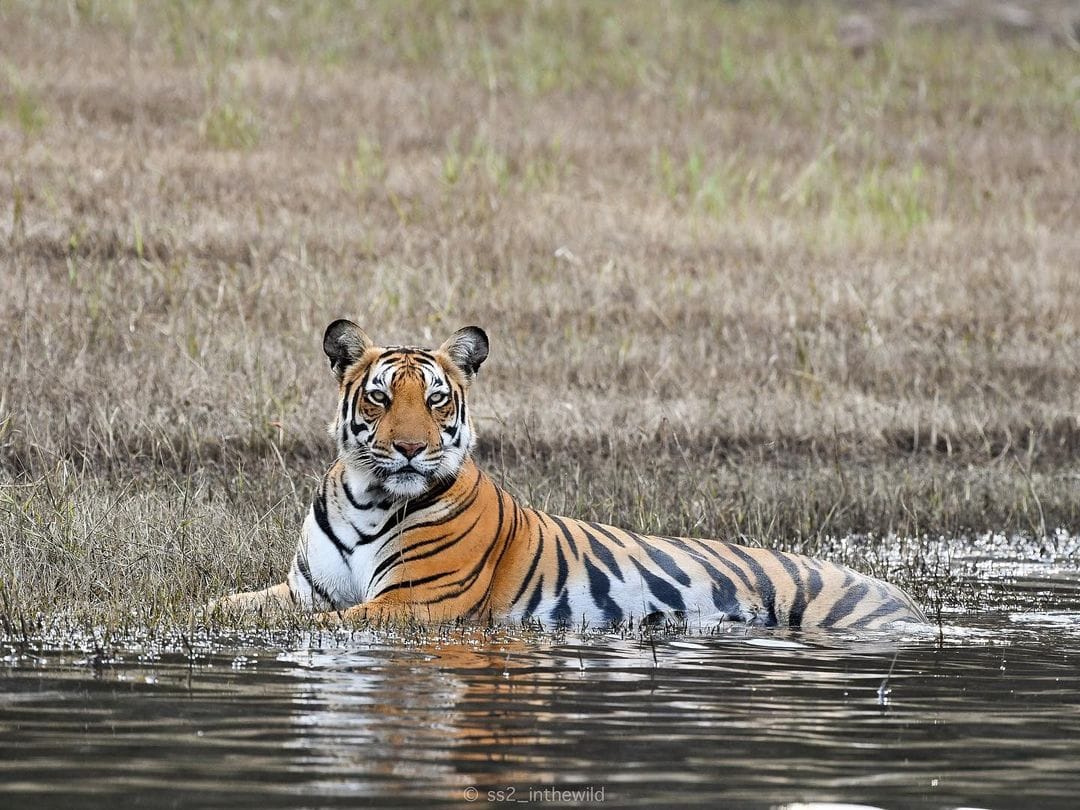
Climate
Bhadra Wildlife Sanctuary has a tropical monsoon climate with four seasons: summer (March- May), monsoon (June-September), post-monsoon (October-December), and winter (January-February). The temperature varies from 10°C to 35°C and the mean annual rainfall varies from 1,200 mm to 2,600 mm.
The best time to visit the sanctuary is from October to March when the weather is pleasant and dry. The monsoon season should be avoided as it can be very wet and slippery.
Flora and Fauna
Plant Species
The Sanctuary is home to a rich variety of flora due to its location in the Western Ghats, a UNESCO World Heritage Site. The reserve has a total of 1200 plant species, including rare and endangered species. The flora of the reserve comprises of:
- Southern moist mixed deciduous Forests: Terminalia tomentosa (Mathi), Lagerstroemia lanccolata (Nandi), Termmalia paniculata (Kiudal)
- Southern dry mixed deciduous Forests: Trees are typically leafless during certain parts of the year.
The reserve also has a variety of medicinal plants, including Acorus calamus, Celastrus paniculatus, and Piper nigrum.
Wildlife
Bhadra Wildlife Sanctuary is one of the most biodiverse regions in India and hosts a variety of wildlife species. It has about approximately 120 species of trees, 107 species of orchids, 250 species of birds, 33 species of reptiles, 81 species of fish, and 120 species of butterflies.
The main attraction of the sanctuary is its population of tigers in the Bhadra Tiger Reserve which is estimated to be around 25-30 individuals. The sanctuary also has other carnivores such as leopards, wild dogs, sloth bears, jackals, hyenas, and civets.
The herbivores include elephants, gaurs, sambar deer, chital deer, barking deer, mouse deer, muntjac, wild boars, and porcupines. The sanctuary also has some rare and endemic animals such as lion-tailed macaques, Malabar giant squirrels, slender lorises, and flying squirrels.
Apart from snakes like wolf snake, common vine snake, bamboo pit viper, king cobra, olive keelback, rat snake, Russell’s viper, etc., you can find other reptiles like Draco or gliding lizards, marsh crocodiles and monitor lizards
Bhadra is also a paradise for birdwatchers as it has more than 250 species of birds. Some of the notable ones are great hornbills, Malabar trogons, Malabar whistling thrushes, emerald doves, ruby-throated bulbuls, Indian pitta, great black woodpeckers, and black eagles.
Attractions
Bhadra Wildlife Sanctuary has many attractions for nature lovers and adventure seekers. Some of them are:
- Jeep Safari
The forest department organizes jeep safaris inside the sanctuary twice a day: morning (6:30 am to 8:30 am) and evening (4 pm to 6 pm). The safari takes you through different habitats and gives you a chance to spot various animals and birds. The safari costs approximately Rs 400 per person for Indians and Rs 800 per person for foreign nationals. Keep in mind that the Jeep Safari is subject to availability and can be affected by weather conditions.
- Bhadra Dam
The Bhadra Dam is located on the western border of the sanctuary and offers scenic views of the reservoir and the surrounding hills. You can also enjoy boating on the reservoir or visit the sunset viewpoint near Lakkavalli village.
- Hebbe Falls
The Hebbe Falls are located in the eastern part of the sanctuary and are accessible by a trek of about 8 km from Kemmangundi hill station. The falls are about 168 m high and have two stages: Dodda Hebbe (big falls) and Chikka Hebbe (small falls). The falls are surrounded by dense forests and coffee plantations.
- Manikyadhara Falls
The Manikyadhara Falls are located on the nearby Bababudangiri hill range which is considered sacred by both Hindus and Muslims. The falls are about 30 m high and have a perennial flow of water. The falls are also known for their medicinal properties.
- Jagara Giant
The Jagara giant is the largest teak tree in Karnataka state with a girth of 5.1 m and a height of 32 m. It is said to be around 400 years old. It is located near Jagara village inside the sanctuary.
Activities
Apart from the Jeep Safari organized by the forest department, Bhadra Wildlife Sanctuary offers many activities for visitors such as:
- Birdwatching
The sanctuary is an ideal place for birdwatching as it has a rich diversity of avifauna. You can spot many colorful and exotic birds such as hornbills, trogons, whistling thrushes, bulbuls, and eagles.
- Trekking
The sanctuary has many trekking trails that take you through different terrains and landscapes. You can trek to Hebbe Falls or Manikyadhara Falls or explore the shola forests or grasslands.
- Camping
The sanctuary has several camping sites where you can pitch your tents or stay in cottages or dormitories provided by the forest department or private operators. You can enjoy bonfires or barbecues at night or go for night walks or safaris with guides.
- Photography
The sanctuary offers many opportunities for photography as it has scenic views of hills, forests, waterfalls, and wildlife. You can capture some amazing shots of nature’s beauty with your camera or phone.
Tourism
Accommodation
If you’re planning to stay overnight in the sanctuary, there are several accommodation options available ranging from budget to luxury. The forest department offers basic dormitory-style accommodation, as well as tents and cottages. There are also several private resorts and lodges located near the park. Make sure to book your accommodation in advance, especially during peak season.
Some of the available options are:
River Tern Lodge
This is a state-run lodge run by Jungle Lodges & Resorts located on a hillock on the edge of the Bhadra reservoir near Lakkavalli village. It has cottages with balconies overlooking the water or log huts with private sit-outs facing the forest. It also has a restaurant serving buffet meals with local cuisine.
Muthodi Nature Camp
This is a forest department-run camp located near Muthodi village inside the sanctuary. It has cottages with attached bathrooms or dormitories with common bathrooms. It also has a dining hall serving vegetarian food.
Bhadra Nature Camp
This is a private camp located near Lakkavalli village outside the sanctuary. It has tents with attached bathrooms or cottages with common bathrooms. It also has a dining area serving vegetarian food.
Entry Fees
Visitors to Bhadra Tiger Reserve are required to pay an entry fee. The fee varies depending on whether you’re an Indian or foreign national, for Indians, it’s around INR 400, and for foreigners, it’s around INR 900.
Timings
The Park is open from 6:00 am to 6:00 pm every day. The best time to visit is between October and May when the weather is pleasant and the park is teeming with wildlife. Keep in mind that the park can get crowded during peak season, so it’s best to book your tickets and accommodation in advance.
Challenges and Threats
Bhadra Tiger Reserve faces several challenges and threats that endanger the survival of its wildlife and ecosystems. Here are some of the most significant ones:
Poaching
Poaching is a significant threat to the tiger population in Bhadra. Tigers are poached for their skin, bones, and other body parts, which are used in traditional medicine and for ornamental purposes. Poachers also target other wildlife such as elephants, leopards, and deer. The reserve has taken measures to tackle poaching, including increasing patrols, setting up anti-poaching camps, and using technology such as drones to monitor the reserve.
Human-Wildlife Conflict
The reserve is surrounded by several villages, and the local communities depend on the forest for their livelihoods. As a result, there is often conflict between humans and wildlife, especially elephants. Elephants raid crops and cause property damage, leading to retaliatory killings by the villagers. The reserve authorities have implemented measures such as electric fencing, compensation for crop damage, and community-based conservation programs to reduce human-wildlife conflict.
Habitat Loss
Habitat loss is a significant threat to the wildlife in Bhadra Tiger Reserve. The reserve is surrounded by human settlements, and there is pressure on the forest resources due to the growing population and agricultural expansion. Deforestation, encroachment, and land-use changes are causing the loss of habitat for wildlife. The reserve authorities have implemented measures such as reforestation, habitat restoration, and eco-development programs to mitigate habitat loss.
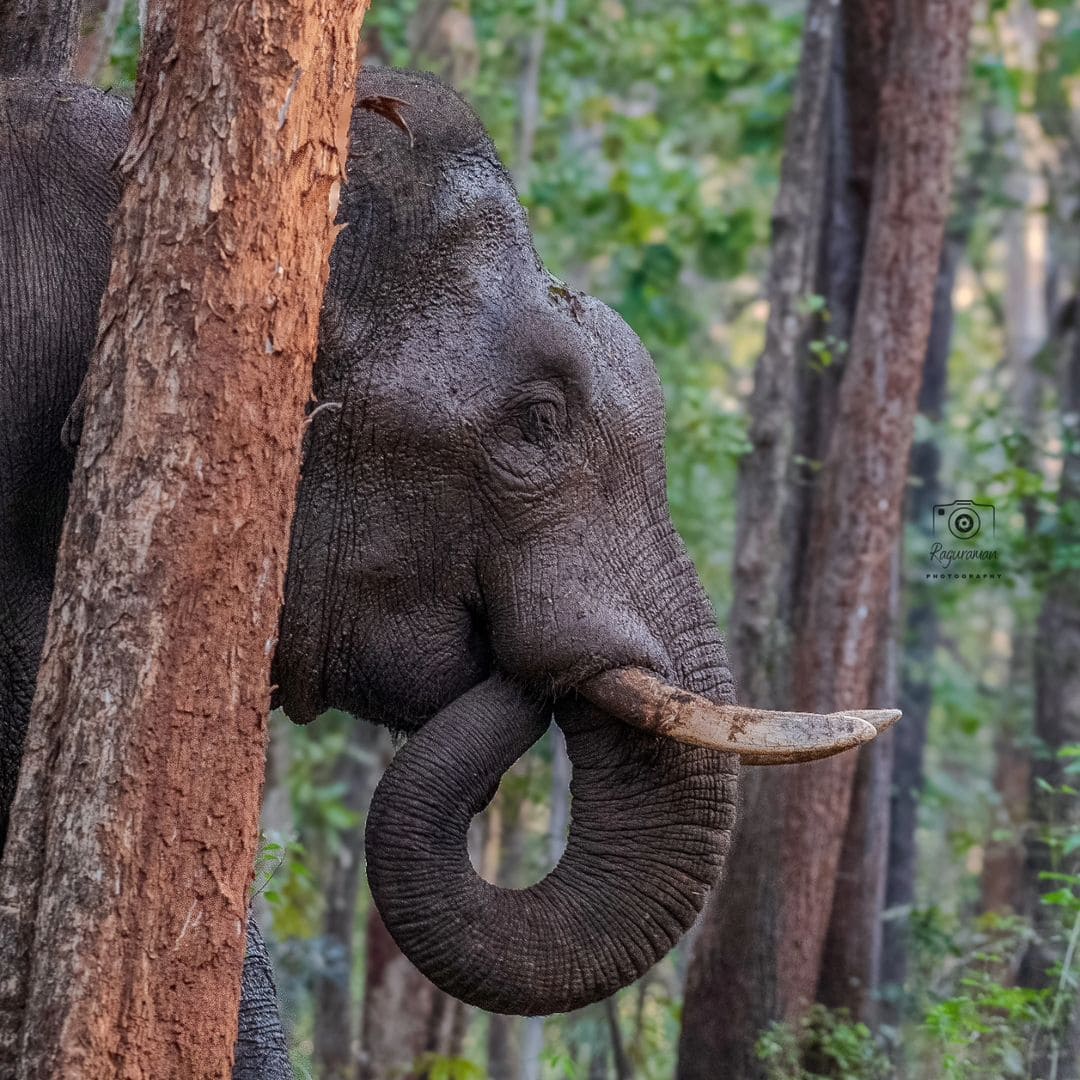
Conservation Efforts
The Bhadra Wildlife Sanctuary has been the focus of numerous conservation efforts aimed at protecting the natural habitat and wildlife.
One of the most important conservation efforts in Bhadra Tiger Reserve is the protection of tigers. The reserve has implemented a range of measures like the use of camera traps to monitor their movements and the establishment of anti-poaching units.
The sanctuary has a good population of elephants and is also an Elephant Reserve. The reserve has implemented a range of measures to protect elephants, including the establishment of elephant corridors and the use of radio collars to monitor their movements.
The Sanctuary administration has also implemented a range of measures to involve local communities in conservation efforts. They have established community-based conservation programs to involve local communities in the protection of wildlife and their natural habitats. The reserve has also established a range of eco-tourism programs to provide local communities with an alternative source of income and to promote conservation efforts.
Frequently Asked Questions
Where is the Bhadra Wildlife Sanctuary and Tiger Reserve located?
Bhadra Wildlife Sanctuary and Tiger Reserve is located in the Chikmagalur district of the Indian state of Karnataka.
What is the cost of admission (ticket price) to Bhadra Wildlife Sanctuary?
The cost of admission to Bhadra Wildlife Sanctuary is around INR 400 for Indians and around 900 for Foreign nationals.
What is the best time of the year to visit Bhadra Tiger Reserve?
The best time to visit Bhadra Tiger Reserve is between October and May when the weather is pleasant and the chances of spotting wildlife are high.
What is famous in Bhadra Wildlife Sanctuary?
The main attraction of Bhadra Tiger Reserve is the Bengal tiger. Apart from tigers, the sanctuary is also home to a variety of other wildlife including elephants, leopards, deer, and birds.
How many tigers can be found in Bhadra Tiger Reserve?
As of the latest census, there are around 25-30 tigers in Bhadra Tiger Reserve.
How to Reach Bhadra Tiger Reserve?
Bhadra Tiger Reserve is located around 285 km from Bangalore and 180 km from Mangalore Airport. The distance between Chikmagalur to Bhadra Wildlife Sanctuary is 79 kilometers. The nearest railway station to Bhadra is Kadur Junction.
What is the distance between Chikmagalur and Bhadra Wildlife Sanctuary?
The distance between Chikmagalur and Bhadra Wildlife Sanctuary is around 80 km.
What are the visiting timings for the tiger reserve?
The visiting timings for Bhadra Tiger Reserve are from 6:00 AM to 8:30 AM and from 3:30 PM to 6:00 PM.
Map
Bhadra Wildlife Sanctuary and Tiger Reserve Quick Guide



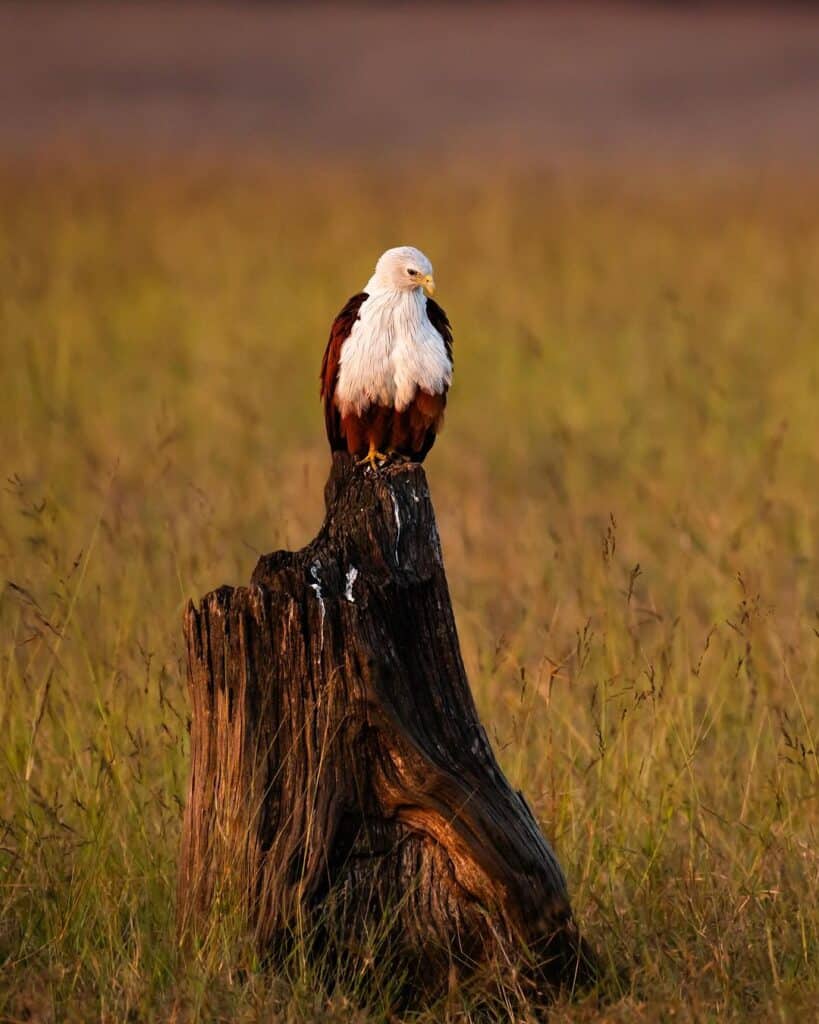
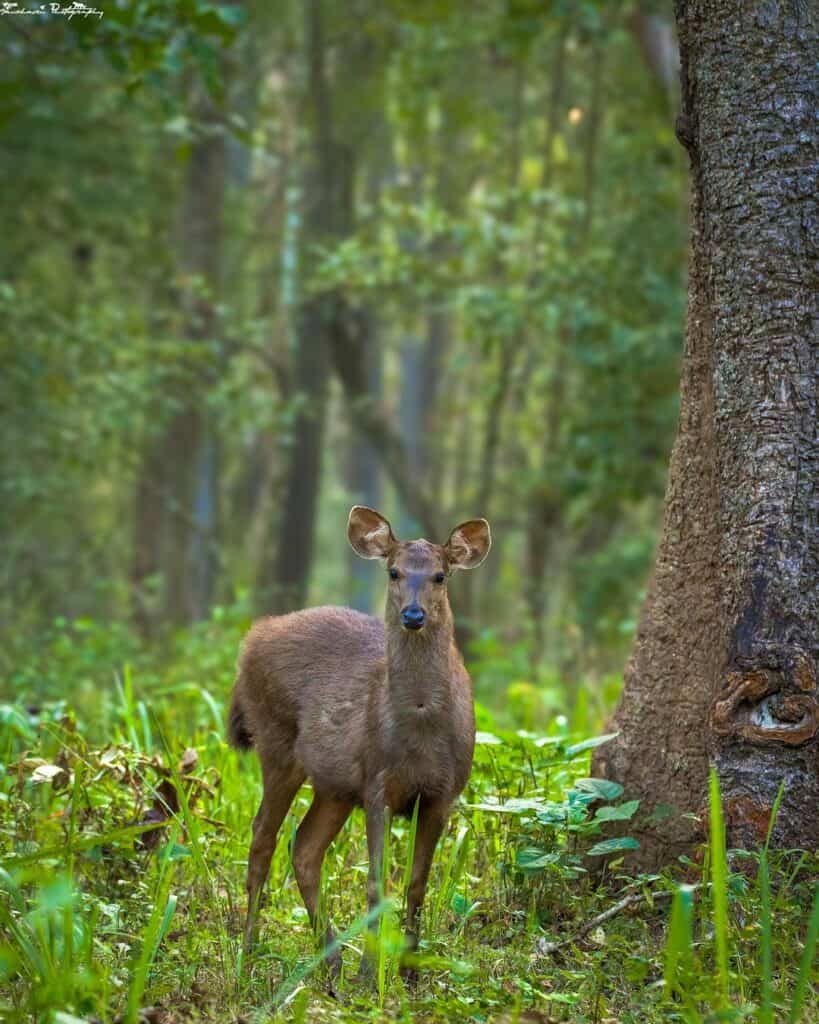
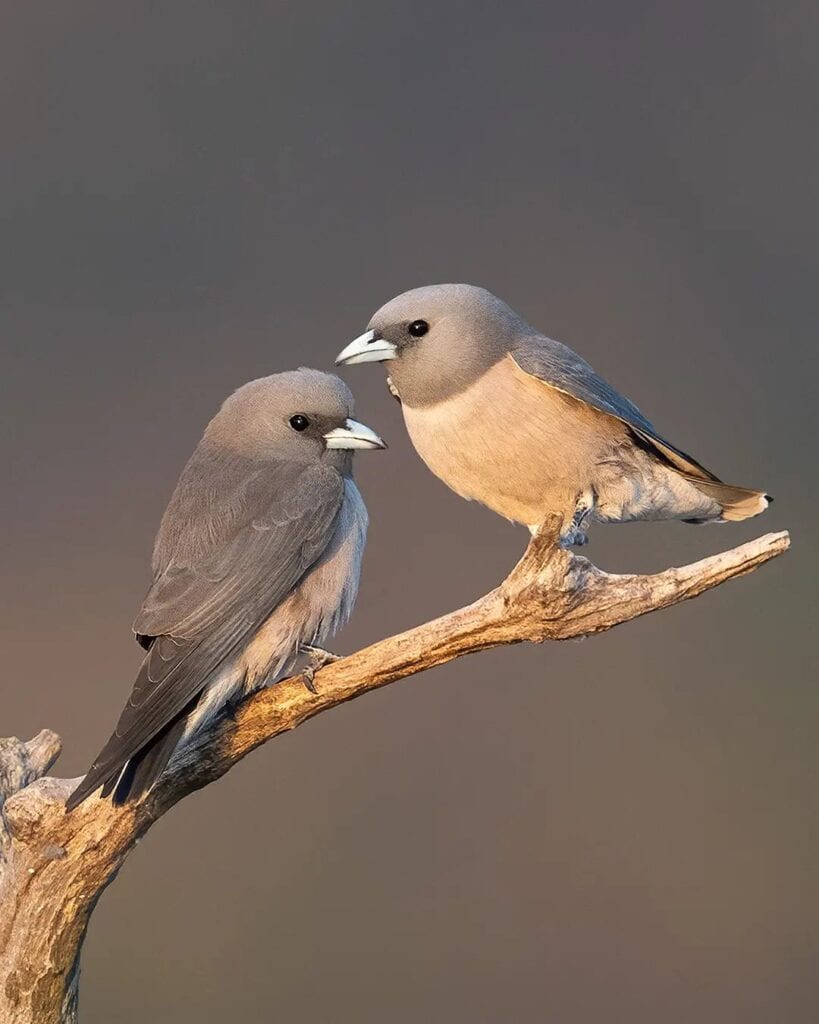
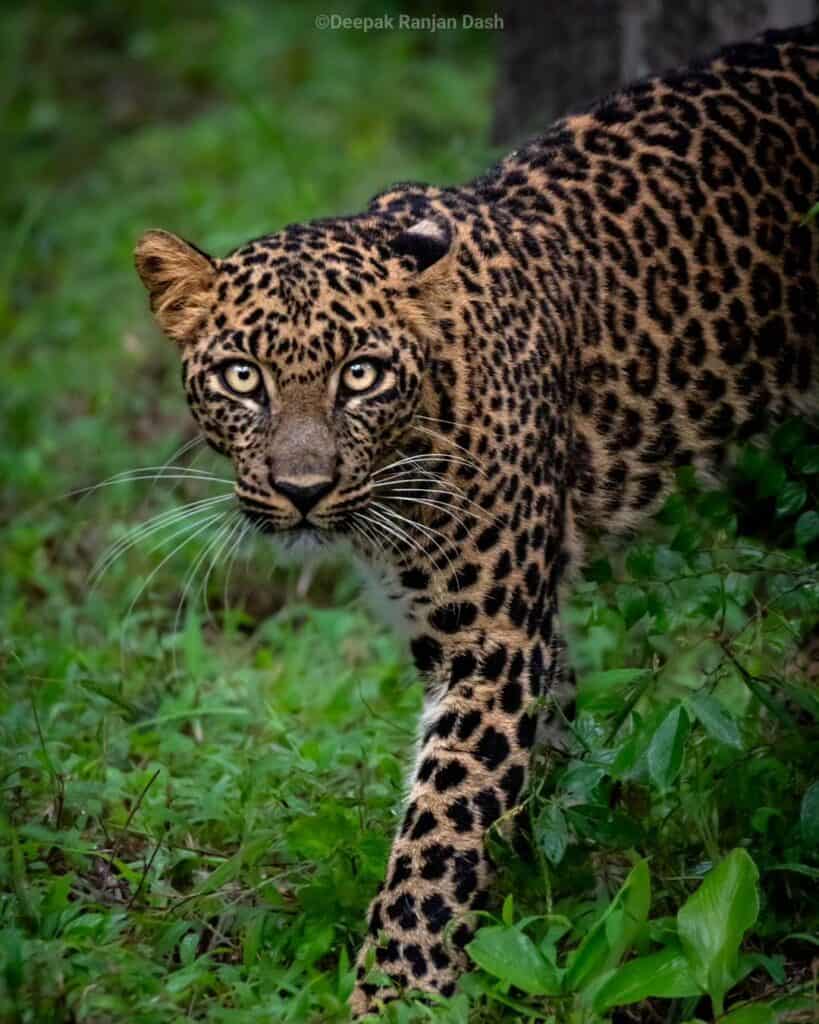
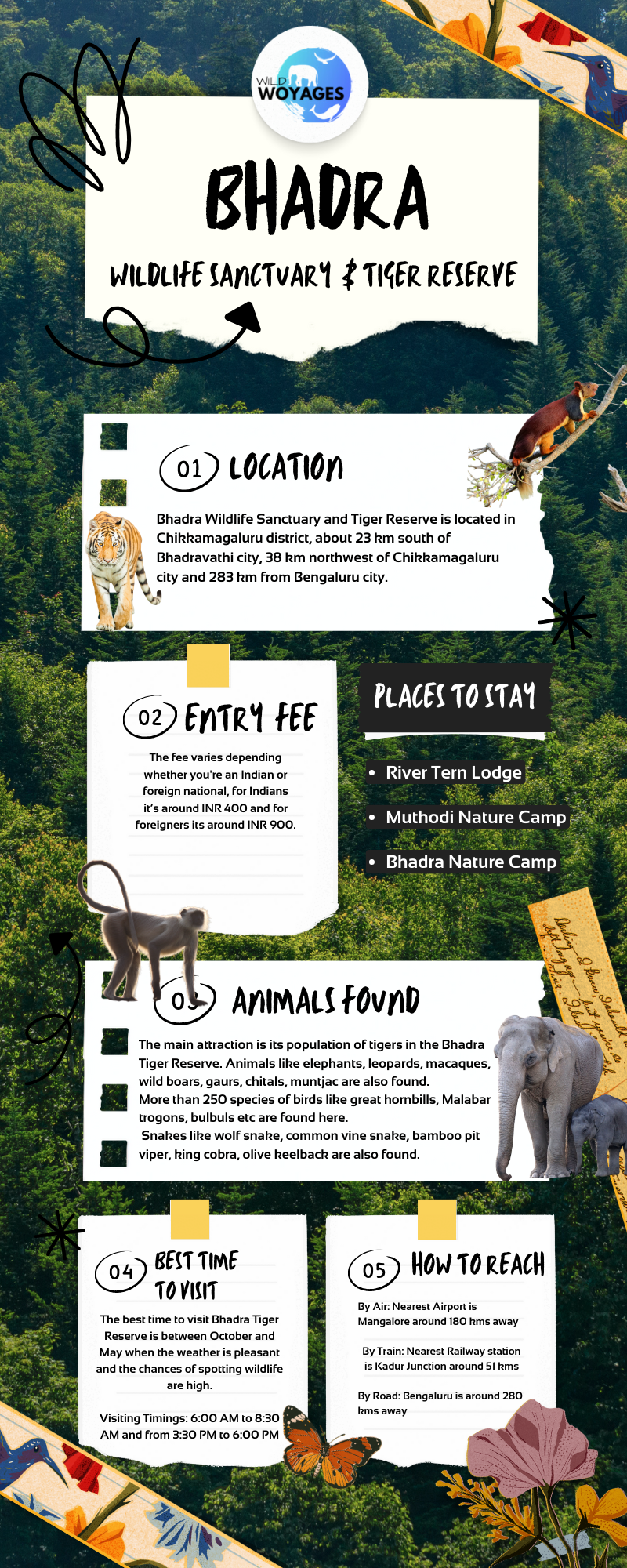
1 thought on “Bhadra Wildlife Sanctuary & Tiger Reserve: A Detailed Guide (2024)”